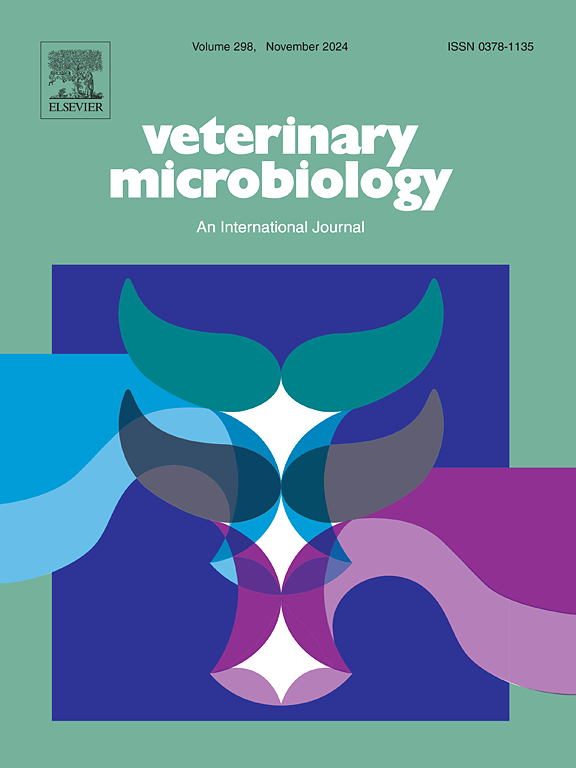What’s up ducks? – Antimicrobial resistance of Escherichia coli isolated from duck farm environment in Poland extended with genomic characteristics of cephalosporin-resistant strains
IF 2.4
2区 农林科学
Q3 MICROBIOLOGY
引用次数: 0
Abstract
Antimicrobial resistance (AMR) in food-producing animals is a source of concern as it may pose a risk to public health. Studies of ducks in this area seem to be scarce. Thus, we aimed to evaluate the AMR occurrence in Escherichia coli from a duck farm environment in Poland. We applied official AMR monitoring methods to investigate AMR in E. coli isolated from boot swabs collected at 306 duck farms in Poland. The samples were screened for indicator, cephalosporin-, carbapenem- and colistin- resistant E. coli. Isolates were tested for antimicrobial susceptibility using the microbroth dilution method and interpreted with epidemiological cut-off values. Whole Genome Sequencing (WGS) of cephalosporin-resistant strains enabled an in-depth insight into specific resistance mechanisms, mobile genetic elements and phylogeny of strains. A total of 340 strains were isolated. The percentage of indicator E. coli equaled 89.9 %, while 19.3 % were obtained through selective screening for E. coli resistant to cephalosporins. Six were recovered on colistin-supplemented MacConkey agar. Among indicator E. coli 81.1 % were resistant and ciprofloxacin, ampicillin, tetracycline and nalidixic acid resistance were the most frequent, followed by folate-path inhibitors. Within the group of strains from cephalosporin resistance screening: 76.3 % exhibited ESBL-, 20.3 % AmpC-, and 3.4 % showed both ESBL- and AmpC- phenotypes. WGS of those strains revealed numerous AMR determinants, not only genes corresponding to mentioned phenotypes but also determinants encoding resistance to other medically important antimicrobials. Our study reveals that E. coli from duck farm environment constitute a reservoir of AMR determinants including those of public health concern.
怎么了,宝贝儿?-从波兰养鸭场环境中分离的大肠埃希菌的抗微生物药物耐药性扩展到头孢菌素耐药菌株的基因组特征
食品生产动物的抗菌素耐药性(AMR)是一个令人关注的问题,因为它可能对公共卫生构成风险。对这一地区鸭子的研究似乎很少。因此,我们旨在评估波兰一个养鸭场环境中大肠埃希菌的AMR发生情况。我们采用官方的AMR监测方法调查了从波兰306个鸭场收集的靴棒中分离的大肠杆菌的AMR。对样品进行指标筛选,对头孢菌素、碳青霉烯和粘菌素耐药的大肠杆菌。采用微肉汤稀释法检测分离株的抗菌药物敏感性,并用流行病学临界值进行解释。头孢菌素耐药菌株的全基因组测序(WGS)有助于深入了解菌株的特定耐药机制、可移动遗传元件和系统发育。共分离到340株。指标大肠杆菌检出率为89.9% %,选择性筛选头孢菌素耐药大肠杆菌检出率为19.3% %。其中6只在添加了粘菌素的麦康基琼脂培养基上恢复。指标大肠杆菌耐药率为81.1 %,以环丙沙星、氨苄西林、四环素和萘啶酸最为常见,其次为叶酸途径抑制剂。在头孢菌素耐药筛选的菌株组中:76.3 %表现为ESBL-, 20.3 %表现为AmpC-, 3.4 %同时表现为ESBL-和AmpC-表型。这些菌株的WGS揭示了许多AMR决定因素,不仅是与上述表型对应的基因,而且还有编码对其他医学上重要的抗菌素耐药的决定因素。我们的研究表明,来自养鸭场环境的大肠杆菌构成了AMR决定因素的储存库,包括那些公共卫生关注的决定因素。
本文章由计算机程序翻译,如有差异,请以英文原文为准。
求助全文
约1分钟内获得全文
求助全文
来源期刊

Veterinary microbiology
农林科学-兽医学
CiteScore
5.90
自引率
6.10%
发文量
221
审稿时长
52 days
期刊介绍:
Veterinary Microbiology is concerned with microbial (bacterial, fungal, viral) diseases of domesticated vertebrate animals (livestock, companion animals, fur-bearing animals, game, poultry, fish) that supply food, other useful products or companionship. In addition, Microbial diseases of wild animals living in captivity, or as members of the feral fauna will also be considered if the infections are of interest because of their interrelation with humans (zoonoses) and/or domestic animals. Studies of antimicrobial resistance are also included, provided that the results represent a substantial advance in knowledge. Authors are strongly encouraged to read - prior to submission - the Editorials (''Scope or cope'' and ''Scope or cope II'') published previously in the journal. The Editors reserve the right to suggest submission to another journal for those papers which they feel would be more appropriate for consideration by that journal.
Original research papers of high quality and novelty on aspects of control, host response, molecular biology, pathogenesis, prevention, and treatment of microbial diseases of animals are published. Papers dealing primarily with immunology, epidemiology, molecular biology and antiviral or microbial agents will only be considered if they demonstrate a clear impact on a disease. Papers focusing solely on diagnostic techniques (such as another PCR protocol or ELISA) will not be published - focus should be on a microorganism and not on a particular technique. Papers only reporting microbial sequences, transcriptomics data, or proteomics data will not be considered unless the results represent a substantial advance in knowledge.
Drug trial papers will be considered if they have general application or significance. Papers on the identification of microorganisms will also be considered, but detailed taxonomic studies do not fall within the scope of the journal. Case reports will not be published, unless they have general application or contain novel aspects. Papers of geographically limited interest, which repeat what had been established elsewhere will not be considered. The readership of the journal is global.
 求助内容:
求助内容: 应助结果提醒方式:
应助结果提醒方式:


